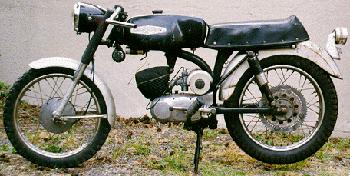
1968 Aermacchi/Harley-Davidson Rapido 125
After restoration

1968 Aermacchi/Harley-Davidson Rapido 125
After restoration

Before restoration
The Aermacchi/Harley-Davidson 125cc Rapido was a new model for the year of 1968. The design for this new machine sprung from its predecessors, the M-50 and M-65. Not only was the motorcycle new, but also unique in that many of the features would not return the following year.
The styling of the bike, given the model designation ML-125, was clearly road-racer inspired. The long and narrow, black tank had indents in the rear for your knees and a wide pebble-finish stripe down the center flanked by thinner white stripes. The seat was also long and narrow with the classic bump-stop at the rear. Both of these features were borrowed from the M-50S/M-65S models, and in 1969 would give way to a shorter, scrambles-inspired tank and a wider, flat dual-seat. The silver, shrouded fenders were also direct descendants of the M-50/M-65 being only slightly larger to house bigger tires. The street-style fenders would only remain through 1969 when the model designation changed to MLS-125. The low exhaust was also unique to the ML-125. A noted suspension peculiarity on the 1968 ML-125 was the short swingarm. This would be lengthened substantially the following year. What the short swingarm lacked by not providing footpegs for a passenger, it gained by providing overabundant wheelies. The short swingarm also housed a 2.50 x 17" tire (matching the front in size), which would be increased to 3.00 x 17" in 1969 and 3.50 x 18" in 1970. Electrically, this first year of Rapido was unique in that there was no ignition switch. One only has to turn the fuel on, engage the choke and kick it over to start. Most of the hardware on the Rapido ML-125 came directly off the M-50/M-65 line; handgrips, clutch and brake levers, speedometer..etc.
Along with the purchase of the Rapido in 1968 for the suggested price of $425, the new owner was allowed a brief brochure explaining how to increase the horsepower output of the engine by some 44 1/2 percent. This information was made available by Harley-Davidsonís racing department. The procedure entailed a new head gasket, an expansion chamber, a shortened clutch hub nut, cylinder and head modifications, and the adjustment of ignition, spark and jets.
The Rapido you see above was acquired by the Digital Garage in August, 1993. The bike was fairly complete but nowhere near capable of running. It has since undergone a complete restoration including; engine rebuild, new exhaust, fork tubes, tires, paint, cables....The only items to remain are new spokes, rims and rebuilding the wire loom (about half missing). This motorcycle should be complete by summer of 1996.
![]()